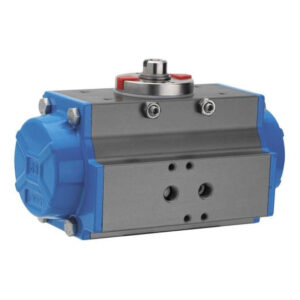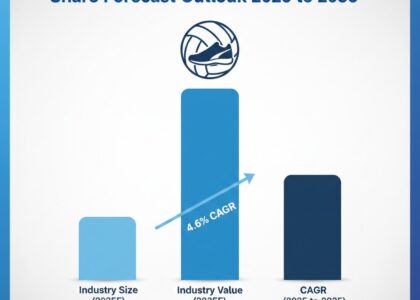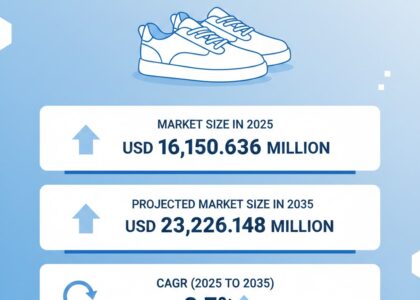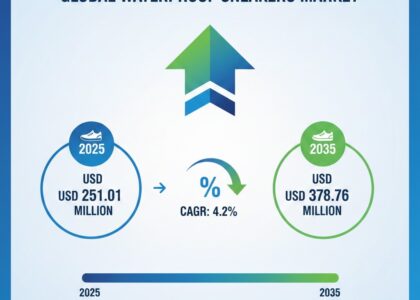
The Pneumatic Actuator Market was valued at USD 14,421.4 million in 2020 and is projected to reach approximately USD 18,035.2 million by 2025, reflecting a year-on-year growth rate of 3.9% in 2025. Looking ahead, the market is expected to maintain steady momentum, expanding at a compound annual growth rate (CAGR) of 4.8% over the forecast period from 2025 to 2035. By the end of this period, the market is forecast to achieve a valuation of around USD 26,841.5 million, driven by the growing demand for industrial automation and energy-efficient actuation technologies.
Driven by industrial automation, increasing investment in smart factories, and stringent safety regulations, the pneumatic actuator market is expected to expand substantially over the coming decade. Manufacturers are innovating with advanced materials, compact designs, and integrated sensor technologies to meet diverse industry needs and regulatory requirements. This has positioned pneumatic actuators as a critical component in the next generation of intelligent industrial systems.
Stay Ahead with Market Trends: Access Your Sample Report Now! https://www.futuremarketinsights.com/reports/sample/rep-gb-4330
Driving Forces Behind Market Growth
- Rapid Adoption of Industrial Automation:
As part of the global transition to Industry 4.0, companies are increasingly integrating robotics, IoT-enabled systems, and programmable logic controllers (PLCs) into their operations. Pneumatic actuators offer the simplicity, durability, and cost-effectiveness needed to support these smart manufacturing environments. They are widely used in processes requiring precise motion control, such as material handling, assembly, and packaging. - Growing Demand for Energy Efficiency:
Energy efficiency is now a central consideration across industrial design and operations. Pneumatic actuators consume significantly less energy than hydraulic systems, especially in applications with intermittent load requirements. With rising energy costs and environmental mandates, industries are moving toward cleaner and more efficient motion control technologies, further driving the adoption of pneumatic systems. - Expansion in Key End-Use Industries:
Sectors such as oil & gas, chemical processing, food & beverage, water treatment, and pharmaceuticals are increasingly utilizing pneumatic actuators to automate valves and control systems. These industries require robust and explosion-proof equipment—areas where pneumatic actuators excel due to their ability to operate without electrical power in hazardous environments. - Technological Innovations and Smart Pneumatics:
The development of smart pneumatic actuators with built-in diagnostics, wireless monitoring, and integration capabilities with industrial control systems is accelerating market growth. These innovations allow predictive maintenance, minimize downtime, and provide real-time feedback, helping companies achieve operational excellence.
Market Challenges & Strategic Responses
- Compressed Air Inefficiency and Energy Loss:
One of the key limitations of pneumatic systems is their reliance on compressed air, which can lead to inefficiencies due to leakage and pressure loss. These issues raise operational costs and impact system performance. To counter this, manufacturers are investing in high-efficiency compressors, better air filtration, and leak detection technologies. - Competition from Electric and Hydraulic Actuators:
While pneumatic actuators are cost-effective and suitable for many applications, electric actuators are gaining popularity in precision control environments due to their programmability and reduced energy loss. In response, pneumatic actuator manufacturers are developing hybrid systems and advanced control valves that offer similar precision and integration capabilities. - Maintenance and Operational Downtime:
Although generally low-maintenance, pneumatic systems can experience issues related to moisture accumulation, contamination, or wear and tear in seals and hoses. Strategic responses include the use of corrosion-resistant materials, sealed units, and integrated moisture separators to extend system life and reduce downtime. - Regulatory and Safety Compliance:
Compliance with international safety standards (e.g., ISO, OSHA, ATEX) and environmental regulations is becoming increasingly stringent, especially in sectors like oil & gas and chemicals. Companies are responding by designing actuators that meet specific certification requirements and can function in extreme or hazardous environments.
Increased Market Demand: Get In-Depth Analysis and Insights with Our Complete Report! https://www.futuremarketinsights.com/reports/pneumatic-actuator-market
Regional Market Outlook
North America:
The North American pneumatic actuator market is mature but still growing, driven by ongoing investments in industrial automation, shale oil production, and wastewater infrastructure. The United States is the dominant contributor, with companies prioritizing plant modernization and energy-efficient technologies. Strict workplace safety and environmental regulations further reinforce the demand for explosion-proof pneumatic actuators.
Europe:
Europe remains a key market due to its strong focus on sustainability, energy efficiency, and automation. Countries like Germany, France, and the UK are leading the adoption of Industry 4.0 practices, particularly in automotive, pharmaceuticals, and food processing industries. The European Union’s regulatory framework encouraging low-emission industrial equipment is expected to continue boosting pneumatic actuator sales.
Asia-Pacific:
Asia-Pacific is the fastest-growing regional market, fueled by rapid industrialization in China, India, Indonesia, and Southeast Asia. The region’s strong manufacturing base, rising investment in smart factory initiatives, and growth in oil & gas and water treatment sectors are major drivers. Additionally, government initiatives like “Make in India” and “Made in China 2025” are expected to accelerate adoption of automation technologies, including pneumatic actuators.
Middle East & Africa:
The pneumatic actuator market in this region is being propelled by robust activity in the oil & gas, mining, and desalination sectors. High ambient temperatures and hazardous conditions favor the use of pneumatic systems due to their reliability and safety. Countries like Saudi Arabia and the UAE are leading infrastructure projects that include the deployment of advanced automation systems.
Latin America:
Although the Latin American market faces economic and political uncertainties, there is steady demand for pneumatic actuators in the mining, food & beverage, and pulp & paper industries. Brazil and Mexico are the primary markets, with a focus on upgrading aging infrastructure and improving operational efficiency through automation.
Automation Auxiliary Industry Analysis: https://www.futuremarketinsights.com/industry-analysis/automation-auxiliary
Key Players in Pneumatic Actuator Market
- SMC Corporation; ABB Ltd.
- Elfor Controls Srl.
- Habonim Industrial Valves & Actuators Ltd.
- Johnson Controls Inc.
- Parker Hannifin Corp
- Metal Works SPA
- IMI Precision- Norgren
- Camozzi SPA
- Bosch Rexroth AG
- Flowserve Corporation
Key Segments
By Product Type:
According to the product type the pneumatic actuator market is categorized into Rack and Pinion Pneumatic Actuator, Scotch Yoke Pneumatic Actuator
By Capacity Type:
According to the capacity type, the pneumatic actuator market is categorized into Light Duty Pneumatic Actuator, Heavy Duty Pneumatic Actuator.
By Operation:
According to the application the pneumatic actuator market is categorized into Double Acting Type Pneumatic Actuator and Spring Return Type Pneumatic Actuator
By Application:
According to the application the pneumatic actuators market is categorized into Industrial Automation, Transportation.
By Region:
On the basis of region, the pneumatic actuators market is categorized into North America, Latin America, Eastern Europe, Western Europe, East Asia, South Asia and Pacific, and Middle east and Africa.
About Future Market Insights (FMI)
Future Market Insights, Inc. (ESOMAR certified, recipient of the Stevie Award, and a member of the Greater New York Chamber of Commerce) offers profound insights into the driving factors that are boosting demand in the market. FMI stands as the leading global provider of market intelligence, advisory services, consulting, and events for the Packaging, Food and Beverage, Consumer Technology, Healthcare, Industrial, and Chemicals markets. With a vast team of over 400 analysts worldwide, FMI provides global, regional, and local expertise on diverse domains and industry trends across more than 110 countries. Join us as we commemorate 10 years of delivering trusted market insights. Reflecting on a decade of achievements, we continue to lead with integrity, innovation, and expertise.
Contact Us:
Future Market Insights Inc.
Christiana Corporate, 200 Continental Drive,
Suite 401, Newark, Delaware – 19713, USA
T: +1-347-918-3531
For Sales Enquiries: sales@futuremarketinsights.com
Website: https://www.futuremarketinsights.com
LinkedIn| Twitter| Blogs | YouTube





